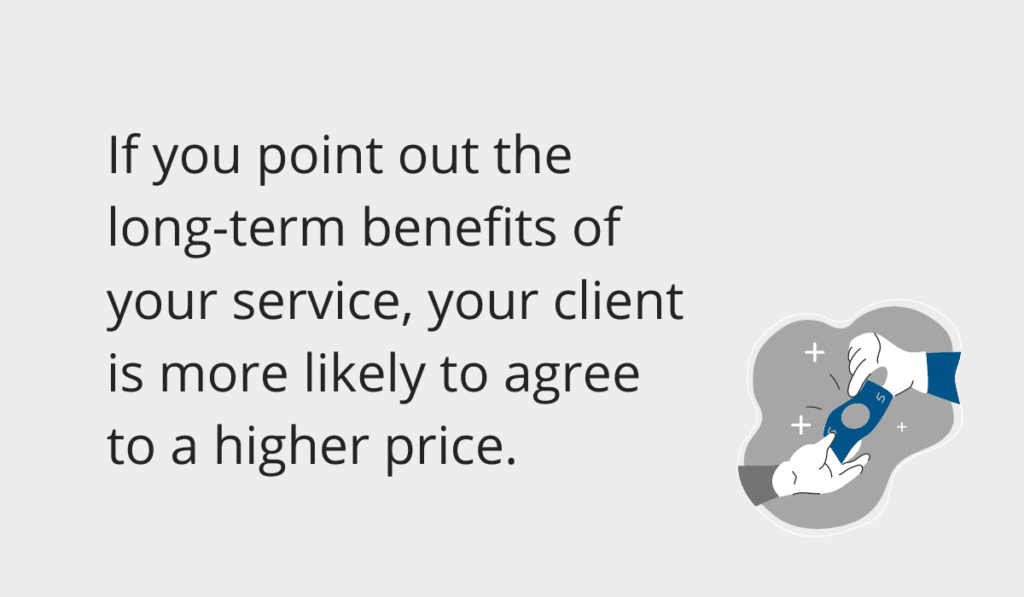Builders and contractors don’t tend to view themselves as salesmen; they focus on construction as their primary area of expertise.
However, whether you like it or not, making a sale is an essential part of the construction industry and can’t be ignored.
Even if you provide the best possible service in town, it won’t mean a thing if you don’t know how to sell it.
In this article, we are covering six common sales mistakes and show you how you can work around them.
Let’s begin.
In this article...
Not Listening Closely to the Client
Being all talk can seriously harm your sales efforts. Sure, it’s a good thing to point out that your company is the right choice for the job, but your main preoccupation should be actively listening to your clients so you can cater to their needs.
Active listening is a technique used in communication to increase the understanding between speaker and listener. Epictetus, a Greek philosopher, wisely said that we have two ears and one mouth so that we can listen twice as much as we speak.
Why is that important in sales?
Imagine walking into a shoe store because you need a nice pair of shoes for your cousin’s wedding.
Now picture that instead of helping you, the salesperson keeps talking about the store and all their shoes and how wonderful they are. Pretty frustrating, right?
People don’t tend to pay close attention when other people talk, but being attuned to the speaker is how you detect what drives them.
Instead of daydreaming or interrupting them with your observations, you should learn to actively observe the speaker’s choice of words and the tone of their voice, but also their body language.
That’s how you can detect what they need.
Believe it or not, 80% of all communication is nonverbal, so start looking at facial expressions, gestures, the direction of the gaze, hand gestures, etc.

If you want to avoid miscommunication, it’s important to actively listen during the questions stage. However, you probably assume that the questions stage is when the client asks the questions, but there’s an even better way to look at it.
You’re the one that should be asking questions, and a lot of them, because the answers will allow you to fully understand the client’s expectations and needs, and plan your project accordingly.
More importantly, doing so will allow you to identify the client’s pain point (i.e., the specific problem they’re trying to solve in the marketplace).
For example, you can ask your client what they are hoping to change about their home and why; this will help you determine their taste, dislikes, and most of all, the problems they are trying to solve.
Maybe they really hate the paint on their walls, or the problems with their plumbing are making them late for work every morning.
To sum up, not listening to your client’s needs and problems actively is a big mistake if you’re hoping to make a sale.
So, don’t forget to ask plenty of questions to find out where your client’s pain point lies.
Waiting Too Long to Follow Up
Imagine that you’ve had your initial meeting with the client and managed to find out what their pain point is. That’s a great accomplishment.
However, the process doesn’t end there, and there is still room for mistakes.
The next mistake you can make is waiting too long to follow up.
It turns out that contractors not submitting their estimates in a timely manner is one of the most common complaints clients have.
If you take too much time between the initial meeting and presenting the proposal, your client will think that they’re not important to you.
They could feel like you’re just stringing them along. This can make them offended and result in them taking their business elsewhere.
Even worse, they will probably share their negative experience with their friends and leave a mean review on Google or Facebook.
None of this can be good for your reputation, so make sure to agree on the deadline for the proposal and make it as short as possible. But how much time is too much?
Well, in most cases, clients usually expect you to make a proposal within a week or two. If you wait longer than that, they will assume that you don’t want the job, as you can tell from the screenshot below.

Now, if you tell your client that you will send them the proposal within a week, make sure you follow through.
If you think that a week is not enough time and you have a lot of work at the moment, inform the client and set another deadline, but try not to take longer than two weeks.
We know that making sure you always set a realistic deadline to compose your proposal and not keep your client waiting too long can be challenging.
However, it’s important to please your client, and they don’t like to wait, so you should get right on it.
Not Going Over the Proposal With the Client
Now that you know that you shouldn’t wait too long with your proposal, it’s time to impart the importance of discussing it with the client. Although common, neglecting to go over the proposal with the client would be a mistake.
After creating a proposal, a lot of constructors will simply email it to the client. Sure, this is fast and convenient, but it could also be a red flag for a potential client.
Look at it this way; your client isn’t as familiar with all the construction terms and their meanings, and he or she will have lots of questions.
You can’t go over all of them through email, and besides, a more personal approach is always better.
Therefore, you should meet with your client in person and go over the proposal face-to-face. In this way, you’ll be able to explain everything and minimize the possibility of misunderstandings.
Any doubts your client might have will be addressed, so they won’t be left confused.
Also, in person, you’ll be able to demonstrate better why your solution to their problem is better than others, why they should work with you, and what makes you unique.
There is no way you could do all of that in writing. What is more, eye-to-eye communication builds trust, so there is a much higher chance you’ll close the deal this way.
Everyone has to feel engaged in the process for your collaboration to be successful.

Speaking of closing the deal, for your client the price will likely be a crucial factor, even a potential dealbreaker.
To find out if he or she is comfortable with the price, you can openly ask the client if they think the price is reasonable. In this way, you can even find out if they’ve obtained any estimates from the competition and act accordingly.
Our point is that you shouldn’t make the mistake of merely sending your proposal via email. Trust us, going through a proposal in person is a sure way of getting a client, and a satisfied one at that.
Handling the Client’s Objections Poorly
After you propose your estimate, the client might have some objections. Be careful how you handle those objections, because being unprofessional in that situation is a good way to lose the client.
Let’s be honest, while making a sale, friction simply can’t be avoided; you just need to learn how to deal with it effectively, in a way that leaves the customer satisfied.
Dealing with disputes and objections can be hard, but in the end, it’s all about perspective. So don’t pack your bags and run home just yet; they are not the end of the world. Instead, look at them as detours on the way to making a sale.
Think of it this way; an objection can simply mean that your client needs some more information and that you need to elaborate a bit more on why your work will improve their situation.
So changing your mindset is really important while dealing with objections.
When your clients share their objections with you, be sympathetic and show them that you understand their concerns.
You can do that by saying that you understand where they come from, and sharing your experiences with other clients that felt exactly the same. Then, do your best to address the issues they’ve raised.
In this way, you will show them respect, and they will not see you as just another soulless money-grabber.
The price tends to be the most common objection, as mentioned earlier. Construction work is quite expensive, so the price will inevitably be a point of negotiation.
In your eyes, the price is always right because you understand the value of your work; the only thing you need to do is convince your client of it.
There are several ways to do that, but the best one is to play the quality card. Point out the hassle and expense of the reworks that they will have to undertake if they choose not to invest in having the work done properly right away.
In other words, if you point out the long-term benefits of paying for quality, your client will be more likely to agree to a higher price.

For example, a client might think that a special thermal isolation facade is too expensive. However, if you explain to them that with a cheaper solution, they’ll need to paint their walls every year due to mold, it won’t seem that expensive anymore.
So there you have it. Objections and disputes are a normal part of life, get used to them, and you’ll see that handling them is not that hard with the right approach.
Comparing Your Business to the Competition
The next sales mistake we’ll discuss should be avoided at all costs, and that is comparing your business to the competition.
It’s especially important not to badmouth the competition. Criticizing others is not a good look and will only make you look petty and unprofessional.
Instead of focusing on what they are doing wrong, you should focus on convincing your clients that you are the right person for the job.
But beware, calling yourself top-notch and overly bragging won’t achieve anything; people like to see proof, so you should be able to present some real results.
The best way to do that is to talk about some of your actual experiences and show examples of your satisfied customers.
Tell their stories and explain how you’ve helped them with their pain points.
You can even have your past clients contact your potential clients to provide them with more information, of course only if they would be interested in such a thing. You don’t want to seem too pushy.
Comparing your prices to those of others is another mistake that should be avoided.
No good can come from this, and you can even give your potential client an idea to continue shopping around in the hopes of finding someone cheaper than you out there.
Also, never underestimate the power of first impressions. Your tools and equipment, workforce, and communication skills are all telling your clients a story, so make it a good one.

You might think these things are irrelevant if you are good at getting the job done, but an average consumer wouldn’t necessarily agree with you. Keep an eye out for how you present yourself, be professional, and keep your equipment clean.
In conclusion, when trying to win a new customer, comparing yourself to other constructors and publicly disparaging them is a mistake. You should rather show them why you stand out from the competition.
Not Going For a Close
Even if you manage to avoid all of the previously mentioned mistakes, it won’t mean a thing if you’re making the next and worst one—not going for a close.
Did you know that 64% of salespeople fail to ask for a commitment from the client?
If you are among them, the reasons for this may vary. Maybe you don’t have enough experience to close a sale? Or perhaps you are too scared to hear “no” as an answer?

Leaving things undefined is never a good idea, so you should immediately ask if you have a deal or not.
However, we understand that asking to close a deal directly can be intimidating and make you uncomfortable. So, here are some unobtrusive ways in which you can ask to close a sale:
- Can we set a date and get started?
- We could start on this date. Does that work for you?
- Is this something you would like to move forward with?
- Which date works for you?
- Can we proceed with the work?
- When would you like us to start working?
- Let me check my schedule. We have a free spot next Monday, does that work for you?
- Which option would you like to go with? Is next week good for you?
But sometimes, you won’t get a clear answer even if you ask. In these cases, you should ask some more questions to determine what makes your client indecisive about closing a deal with you.
After you find out what’s making them uncertain, it will be much easier to make an offer they can’t refuse.
So there you have it, you don’t need to be a born salesman to close a deal. The only thing you need to master is the art of asking the right questions, and you’ll be closing sales in no time.
Conclusion
Making a sale is an essential part of the construction business.
Nowadays, selling is all about connecting with potential customers and understanding their points of view so that you can provide the best possible solution.
There are a lot of factors to keep an eye on, and it can all seem overwhelming. But don’t worry, by avoiding these common sales mistakes and following the advice we gave you it won’t be a problem to make lots of new satisfied clients.
Good luck!





